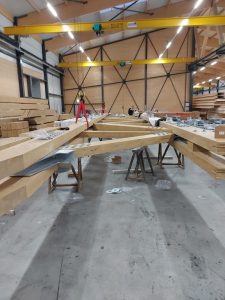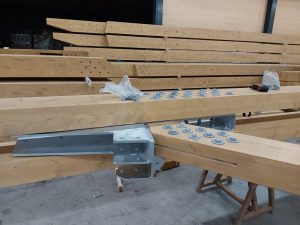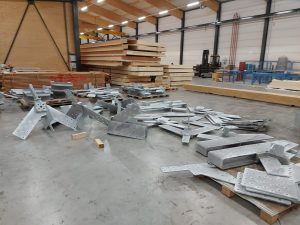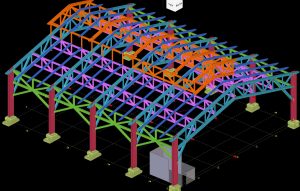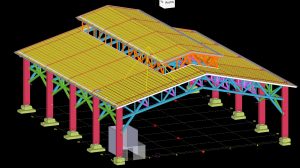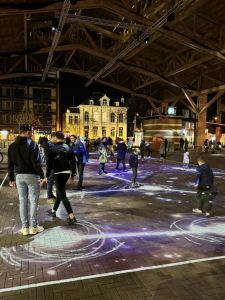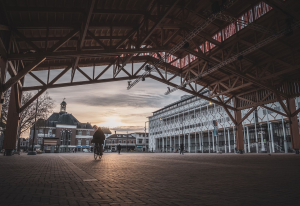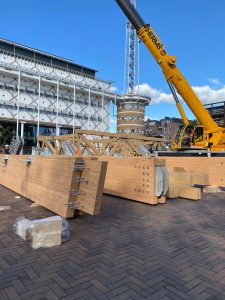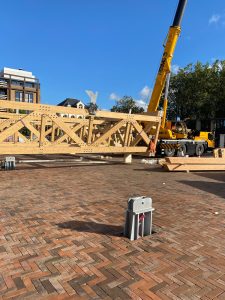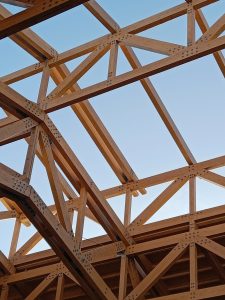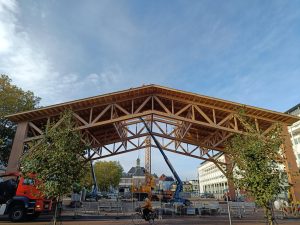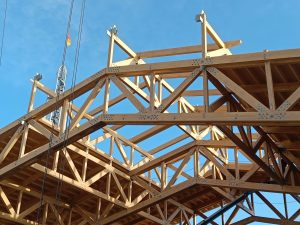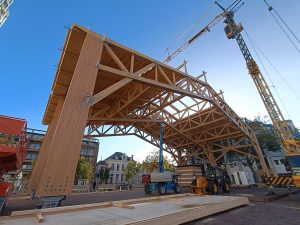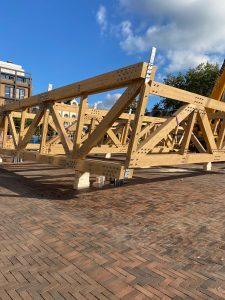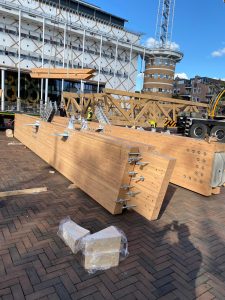 Vencedor da categoria nos países:
Vencedor da categoria nos países:
Markthal, Apeldoorn
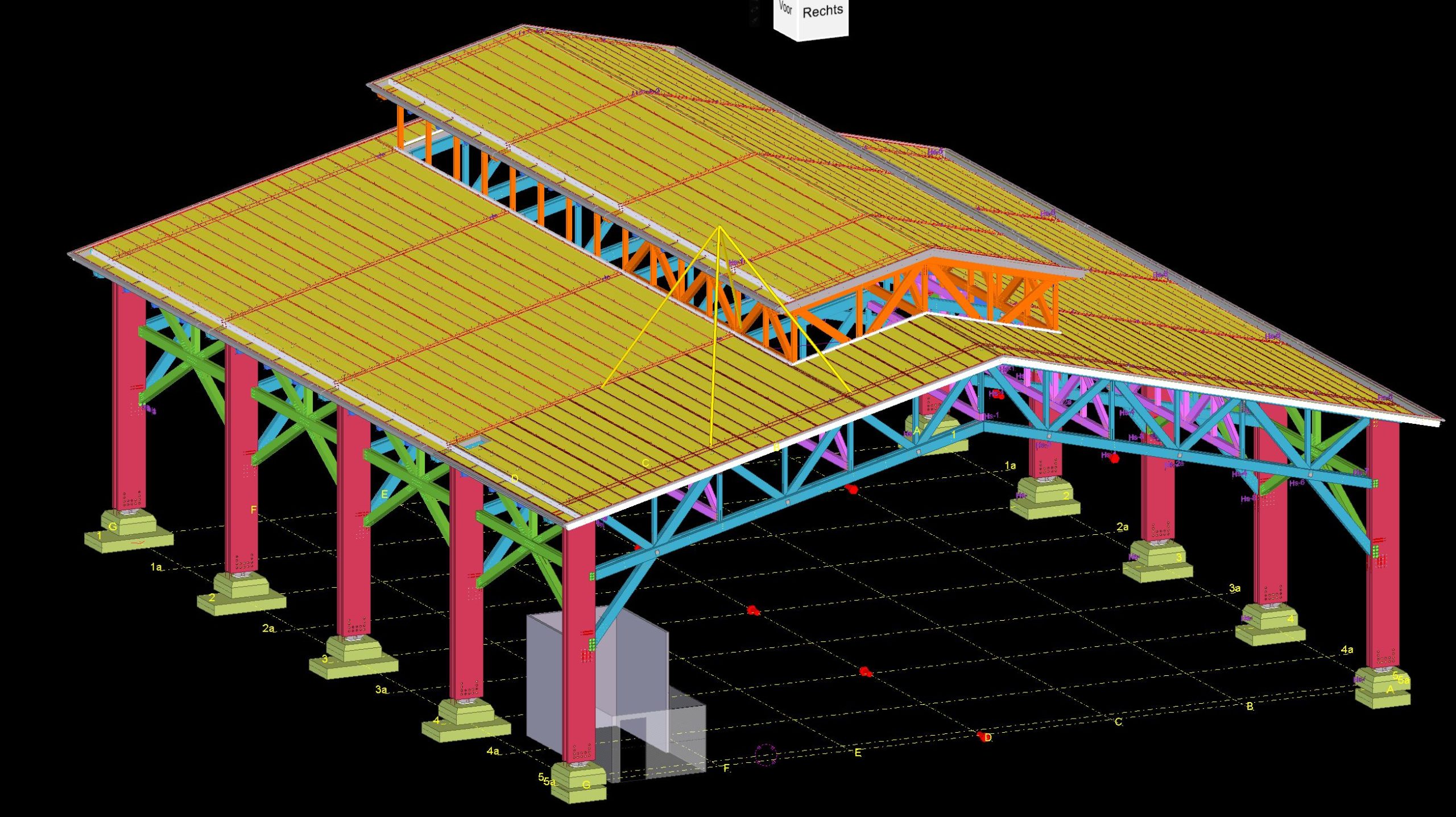
| Categoria | Projectos Desportivos e/ou Recreativos |
|---|---|
| Ano | 2024 |
| País | Benelux |
| Organização | Teken- en Adviesburo Gerard van Meerveld |
| Parceiros do Projeto | Draisma Bouw, Heko Spanten, Adviesbureau Lüning, Van Tetterode glass studio en Architectuur door West 8 |
| Autor | Gerard van Meerveld |
| Cliente | Gemeente Apeldoorn |
| Local de construção | Apeldoorn |
| Tags | Tekla StructuresTimberSteel |
Het project
Apeldoorn staat bekend als een warme, groene stad op de Veluwe. Het marktplein was tot heden ‘ongezellig’ en leeg. Hier heeft de Apeldoornse Markthal verandering in gebracht. Een houten markthal die gebruikt kan worden voor de markt en voor allerlei andere evenementen, zoals de kermis of liveoptredens.
Houten overkapping
De Markthal is een grote houten overkapping met een overspanning van ca. 32 meter. Het gebruikte materiaal is met name hout, alleen voor enkele knooppunten is staal gebruikt. Het gebouw is voorzien van gekleurd glas, waardoor het licht naar binnen ‘beamt’. Het plein is hiermee gedeeltelijk overdekt en voor alle weersomstandigheden goed geschikt. De totale hal is 35 bij 42,5 meter groot en ongeveer 17 meter hoog, een echte eyecatcher. Het dak heeft een zadeldakvorm met een deels verhoogd midden dak, ook wel een lantaarn genoemd. De gevel van het verhoogde dak is dichtgezet met glazen V-vormige delen, terwijl het lagergelegen dak met houten V-vormige delen is bekleed. Verder is de hal voorzien van bitumineuze dakbedekking, wat ervoor zorgt dat de hal beschermd is tegen weersinvloeden.
Het ontwerp is gemaakt in opdracht van de gemeente Apeldoorn. Projectpartners zijn onder andere: hoofdaannemer Draisma Bouw, Heko Spanten, Adviesbureau Lüning, Van Tetterode Glass Studio en architectuur door West 8.
BIM
Alle uitvoerende partijen zoals de detailconstructeur, modelleur, aannemer, producent gelamineerd hout en staalleverancier hebben op hoog niveau gebruikgemaakt van BIM. De controle is bijna volledig door middel van IFC-modellen gerealiseerd. Ook is de bouwplaats volledig 3D ingemeten, wat is geëxporteerd naar IFC, waarna dit rechtstreeks in het Tekla-model kon worden geïmporteerd. Alle onderdelen van de gehele constructie zijn volledig op CNC-machines gemaakt, waarvoor ook alles uit het 3D-model geëxporteerd moest worden naar de diverse machines in hun eigen taal.
Tekla Structures
Tekla Structures is gebruikt door veel eigen componenten te maken en te gebruiken in het modelleren. Dit resulteerde in een model met een grote mate van beheersbaarheid in het wijzigen van processen, wat een wens c.q. eis was van de architect en hoofdconstructeur. Door wijzigingen door te voeren in het gebruikerscomponent, was dat in veel gevallen eenvoudig door te voeren. Ten behoeve van prefab voormontage in de fabriek van vakwerk spanten zijn er veel montagecodes in het 3D-model opgenomen in de onderdelen. Met mooie duidelijke tekeningen t.b.v. de montage als resultaat wat de montagetijd duidelijk verkort heeft.
Maakbaarheid
Het volledige model is gemaakt op LOD400, waarbij we steeds de maakbaarheid op de machines maar ook de montagevolgorde in de gaten moesten houden. Qua geometrie was er een duidelijk verschil in de houtconstructie en de stalen delen. De houtconstructie is opgebouwd uit alleen vierkante of rechthoekige elementen, terwijl bij de stalen delen veel vrij gevormde gesneden platen in alle vormen en maten gebruikt zijn. Qua volumes en gewichten gaat het over ca. 220 kubieke meter hout en ca. 31 ton stalen delen met 47.000 schroeven en ca. 13.000 bouten, moeren en ringen.
Duurzaamheid
Zoals hierboven al genoemd: op wat stalen knooppunten na is de Markthal helemaal van hout. Dit heeft als groot voordeel dat het duurzaam is. Hout groeit en zet tijdens dat groeiproces CO₂ om in hout. Zo ontstaat er een fantastisch ecosysteem dat afval omzet in een duurzaam bouwmateriaal. De speciale dakbedekking beschermt de hal tegen weersinvloeden. Tot slot liggen er zonnepanelen op het dak.
Foto’s: Draisma Bouw
- https://www.youtube.com/watch?v=j4uIryfsaQ4
- https://www.youtube.com/watch?v=CHTXujNYbvk&t=5s&ab_channel=Bouw.live
Op onderstaande website van Gemeente Apeldoorn staat een stuk tekst over de markthal met uitleg:
https://www.apeldoorn.nl/nieuwbouw-en-ontwikkeling/binnenstad/pleinvandestad
The project
Apeldoorn is known as a warm, green city on the Veluwe. Until now, the market square was ‘unsociable’ and empty. This has been changed by the Apeldoorn Market Hall. A wooden market hall that can be used for the market and for all kinds of other events, such as the fair or live performances.
Wooden canopy
The Market Hall is a large wooden canopy with a span of about 32 metres. The material used is mainly wood, with steel used only for some junctions. The building is fitted with coloured glass, allowing light to ‘beam’ in. This makes the square partially covered and suitable for all weather conditions. The total hall measures 35 by 42.5 metres and is about 17 metres high, a real eye-catcher. The roof has a gable roof shape with a partially raised middle roof, also called a lantern. The facade of the raised roof is sealed with glass V-shaped sections, while the lower roof is clad with wooden V-shaped sections. Furthermore, the hall is fitted with bituminous roofing, which ensures that it is protected from the weather.
The design was commissioned by the Municipality of Apeldoorn. Project partners include: main contractor Draisma, Heko Spanten, Houtbouw, Adviesbureau Lüning, Van Tetterode glass studio and architecture by West 8.
BIM
All executing parties such as the detailed structural engineer, modeller, contractor, manufacturer of laminated timber and steel supplier used BIM at a high level. Control was achieved almost entirely through IFC models. The construction site was also fully 3D measured, which was exported to IFC, after which it could be imported directly into the Tekla model. All parts of the entire structure were made entirely on CNC machines, which also required everything from the 3D model to be exported to the various machines in their own language.
Tekla Structures
Tekla Structures was used by creating many proprietary components and using them in modelling. This resulted in a model with a high degree of manageability in changing processes, which was a wish or requirement of the architect and chief structural engineer. By making changes in the user component, this was easy to implement in many cases. For prefabricated pre-assembly in the factory of trusses, many assembly codes were included in the 3D model. This resulted in nice, clear drawings for assembly, which significantly reduced the assembly time.
Manufacturability
The entire model was made on LOD400, where we always had to keep an eye on manufacturability on the machinery but also the assembly sequence. In terms of geometry, there was a clear difference between the timber construction and the steel parts. The timber construction is made up of only square or rectangular elements, while the steel parts used many freely shaped cut sheets in all shapes and sizes. In terms of volumes and weights, it is about 220 cubic metres of wood and about 31 tonnes of steel parts with 47,000 screws and about 13,000 bolts, nuts and washers.
Sustainability
As mentioned above: apart from some steel junctions, the Market Hall is made entirely of wood. This has the great advantage of being sustainable. Wood grows and converts CO₂ into wood during that growth process. This creates a fantastic ecosystem that converts waste into a sustainable building material. Special roofing protects the hall from the weather. Finally, there are solar panels on the roof.
Photos: Draisma Bouw
